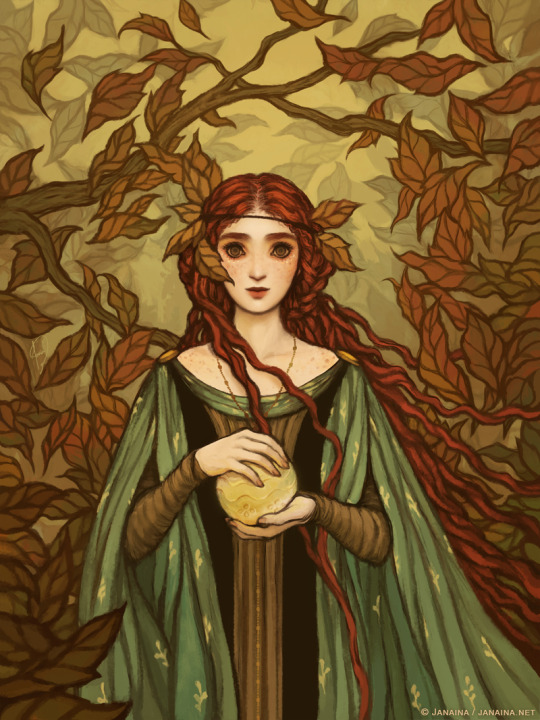Text
Mythological Throwback Thursday: Mermaids and Mermen

It’s time for a special Mythological Throwback Thursday! In honour of Mermay, we’re looking into the depths of mermaid and merman lore. Let’s dive in!
Mermaids are one of the oldest mythological creatures around. Many parts of the ancient world, during various periods, worshipped a goddess known as Atargatis, or Derceto. Originating in Syria, she was a goddess of fertility, a protector of her people, and was often depicted with a fishtail instead of legs. In one origin tale, she is said to have become pregnant by a handsome shepherd boy, Caystrus. Rather than give birth, she tried to drown herself and instead morphed into a half-fish, half-woman.
In ancient Mesopotamia there was also a god known as Oannes, who was depicted as a fish with human feet and also a human head alongside its piscine one. During the day, he would surface in the Persian Gulf and come to shore, instructing those he met in writing, the arts, and the sciences. Smart fish.
Of course, we couldn’t go without mentioning Triton, the Greek god, messenger of the sea and son of Poseidon. A classic merman, he wielded a trident and also possessed a magical conch shell which could control the waves. Triton sired an entire race of merfolk, also called tritons. They had similar powers to their father, but looked rather less human, with gills and broad mouths filled with sharp teeth.
While mermaids are near-universally regarded as highly feminine and attractive, the same cannot be said for their male counterparts. In many parts of the world, mermen were thought of as ugly creatures. In Ireland for example, where merfolk were called merrow, the males were described as having green hair and teeth, both scaly legs and a tail, and stubby arms like fins. As with all merrow, the males had peculiar hats that they needed to wear to be able to live beneath the waves. One type of mermen in Finnish mythology, vetehinen, were helpful, green-bearded fellows with skill in medicine and lifting curses. However, there are also Näkki, which are handsome from the front but hairy and unpleasant from behind. Finnish parents would tell their children that Näkki lay in wait in reflective water, to reach up, drag down and drown inquisitive or vain boys and girls. Creepy.
The image of a man-fish hybrid has also appeared in Polynesian mythology. Avatea, a god of the Cook Islands, is a half-man, half-fish lunar god. Unlike the other merfolk, however, Avatea was split vertically, with his right half being a man and the left being a fish. What a twist!
It seems that wherever humans depended on the ocean, they personified its fickle nature. Perhaps this is the reason for the dualistic personalities sometimes depicted: mermaids good, mermen bad.
If you dig merfolk, you should check out our spin on The Little Mermaid, set in old Down East Maine: Low Tide, by A.M Leibowitz. Download our app Beyond Books for iOS here!
327 notes
·
View notes
Note
Mystical creatures in Turkey??
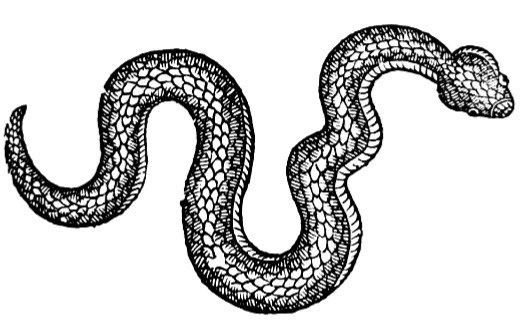
Şüräle - much like the Leshy. He can shapeshift into many different forms. As a human, he looks like a peasant with glowing eyes, and his shoes are on backwards. A person who befriends Şüräle can learn the secrets of magic. Farmers and shepherds would make pacts with the Şüräle to protect their crops and sheep. Şüräle has many tricks, including leading peasants astray, making them sick, or tickling them to death. They are also known to hide the axes of woodcutters. A person gets lost in the woods when a Şüräle crosses their path. To find the way out, you have to turn your clothes inside out and wear shoes on opposite feet.
Biçura - Traditionally, every house is said to have a Biçura. It has also been said that a Biçura can take on the appearance of cats or dogs. It wears red dresses. When she inhabits a house, she lives behind the stove or in the cellar. Similar to a Brownie spirit.
Meçkey - vampiric creatures with two hearts and two souls. Some of them made their way out of their grave with bare hands. Wandering around forests, weak and with bloody hands and torn-off fingernails. They would fly at night in a form of an owl and attack night-time travellers and people who simply wander off into the woods at night, sucking out their blood and eating out their insides. Meçkey could also be satisfied with animal blood, for a short period of time.
Susulu - mermaid creature. They are conventionally depicted as beautiful with long flowing hair. Susulus appear in Turkic folklore as unlucky omens, both foretelling disaster and provoking it like mermaids. Susulus have also been described as able to swim up rivers to freshwater lakes. They are usually the ghosts of young women who died a violent or untimely death, perhaps by murder or suicide, and especially by drowning. Susulus are said to inhabit lakes and rivers. They appear as beautiful young women with long green hair and pale skin, suggesting a connection with floating weeds and days spent underwater in faint sunlight. They can be seen after dark, dancing together under the moon and calling out to young men by name, luring them to the water and drowning them.
Yuxa - every 100 year old snake would turn into a Yuxa. It is a legendary creature with a dragon’s head, which may be said to breathe fire or possess a venomous bite, a reptilian body, two legs (sometimes none), and a barbed tail. It can turn into handsome young men and beautiful young women to seduce, protect, or terrify the people around them as their whim dictates.
122 notes
·
View notes
Text
I was reminded of one of my very favorite parts of Irish folklore, and now I have to tell you all about it. I like to call it “Cu Chulainn’s fear of boobies.”
There is never a moment I don’t find this hilarious.
Cu Chulainn’s fear of boobies is first mentioned in the story in which he becomes a warrior. You know this one; it’s very famous. It’s in the Tain, and everything. Cu overhears Cathbad the druid saying that whoever takes up arms that day with live a life of glory, so Cu runs off to do just that and ends up receiving Conchobor’s weapons and chariot because he’s Cu Chulainn who cares if he is six years old he’s too cool for other weapons and chariots.
So Cu and the charioteer (who’s probably wishing he’d retired) ride off and Cu ends up challenging these three foreign warriors to a battle while the poor charioteer bites his fingernails and hopes he’s not about to watch a six-year-old be violently decapitated (spoilers, he’s Cu Chulainn, he does the decapitating, while the people in the castle are wondering what the SHIT is happening down there).
After killing three grown men, lust for blood not sated, Cu Chulainn heads home, pausing on the way to kidnap a bunch of animals and tie them to the chariot. And that’s how he returns to Emain Macha, thundering along in this chariot, screaming with rage, with all this bewildered swans and deer and shit running along wondering what the fuck is happening.
Someone sees this and tells Conchobor, “oh shit oh shit Cu Chulainn is going to kill us all” to which Conchobor presumably replied “what” and had to have the whole thing explained. After someone patiently told him about this extremely angry six-year-old with all the animals, Conchobor said, “No, it’s cool, just send out a bunch of women to show him their boobs” to which I can only imagine the warriors went, “Boobs, sir?” and Conchobor confidently said, “Boobs. Trust me on this, guys.”
Since everyone in Ulster does trust Conchobor, despite mountains of evidence telling them they shouldn’t, a bunch of women -in some versions led by Conchobor’s own wife- go out and flash their boobs at Cu Chulainn. Cu is so embarrassed by all the naked titties that he flings himself out of the chariot and covers his eyes. The Ulster warriors grab him and dunk him in a barrel of water, which immediately begins to boil because that’s how pissed this child is. Angry enough to boil water on contact. They dunk him in a second barrel, which begins to steam. They dunk him in a third one which stays cold and then Cu’s not angry anymore, and then everyone goes and gets drunk or something, I don’t know.
Hey wait! You might say. Cu was only six in that story! And six-year-olds are dumb! That doesn’t mean he’s afraid of boobies!
WELL GUESS WHAT IT HAPPENS AGAIN LATER IN THE ULSTER CYCLE.
Keep reading
1K notes
·
View notes
Photo

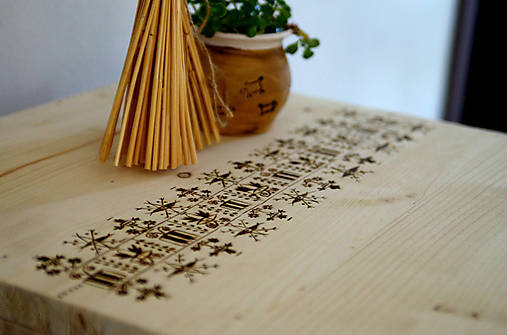
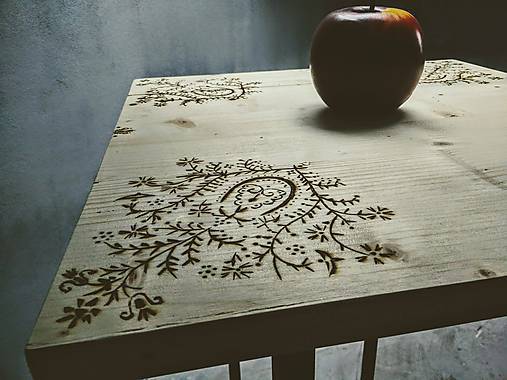
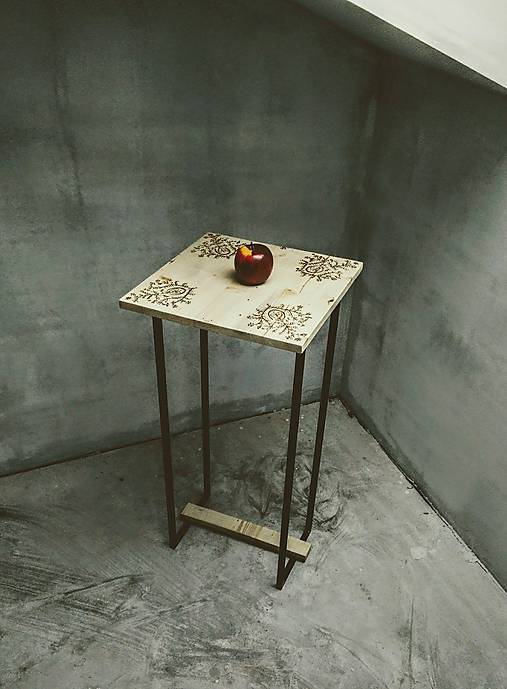
Folklorized furniture part 2.
I especially love these burned-wood pieces that imitate traditional embroidery.
Found on sashe.sk
270 notes
·
View notes
Text
Hey guys, a little bit about La Muerte in Mexican folklore:
She’s described as a very pale and very skinny lady, but it is the poetic way of saying she’s a skeleton.
She is also known as Catrina, which is a specific word for a style of very elegantly dressed women. The male word is Catrín.
She rides a motherfucking bicycle while wearing a tube dress and high heels. If you don’t respect her for being death herself you should based on this fact.
She is incredibly sassy and done with everyone. She has heard all sorts pleads, gambled all sorts of trades, offered all sorts of bribes, been offered all sorts of riches, granted extra hours of life, drank all sorts of alcohol offers, been a therapist to all sorts of people who can’t digest their inevitable death, chased, dated AND married men who just didn’t feel like dying yet, she’s down for whatever because she knows you’ll die either way.
She’ll laugh at your face, she’s savage.
She’s not the Grimm Reaper, she’s not here to reap you, she’s your ride to the underworld, ring ring sweetie hop on that bicycle.
She has all sorts of media dedicated to her, and it can be either as depressing as The Raven or as entertaining as The Devil Went Down to Georgia.
She’s not good nor evil, she is death and she’s here to get her job done.
467 notes
·
View notes
Photo




Folklorized furniture part 2.
I especially love these burned-wood pieces that imitate traditional embroidery.
Found on sashe.sk
270 notes
·
View notes
Photo
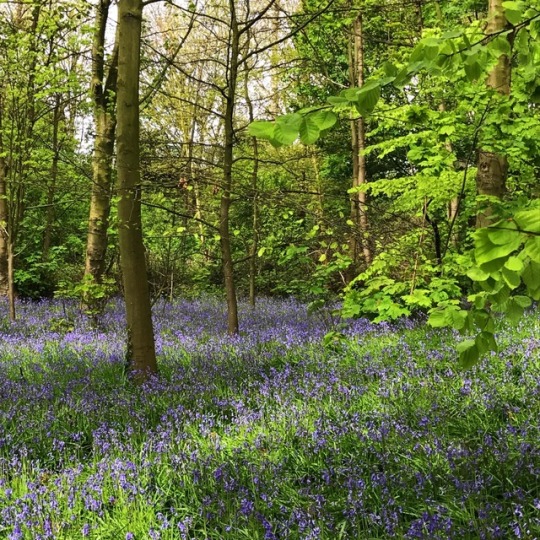



Bluebell woods at Speke Hall in Liverpool, England
473 notes
·
View notes
Note
I once red in a book that there were a few ways to gain the sight. One is to be the seventh son of a seventh son (or daughter, or child since gender doesn't really matter. it's the number that's magical). Another is to pour a faeries bathwater in your eye. My 4th grade class was obsessed with the Spiderwick Chronicles, so we set up a faerie resting place. The next day, the food was gone, and i poured the cap of water in my eye. Imagine if, little did we know, it had worked, and (1/2)
(2/2) an unsuspecting student walked onto campus, able to see without a moodring through their left eye
206 notes
·
View notes
Photo

Not exactly where I thought this passage was heading, but I like it nonetheless.
from The Devil’s Plantation: East Anglian Lore, Witchcraft & Folk-Magic by Nigel G Pearson.
429 notes
·
View notes
Photo

Kelpie
Creepy horses man, they creep me out just enough to want to paint them.
4K notes
·
View notes
Photo



“Once upon a time, there was…”
Inspired by some fairytale and folklore research. Vest available here.
413 notes
·
View notes
Photo

Douen. Trinidadian folklore. Carnival. Trinidad and Tobago.
The Douen is a character from Trinidad and Tobago folklore, it is believed they are the lost souls of children that had not yet been baptized or christened. Their most recognized characteristic are their feet that are said to be backwards, with the heel facing the front.
1K notes
·
View notes
Text
Edible Magickal Flowers and Folk Lore

The culinary use of flowers dates back thousands of years to the Chinese, Greeks and Romans. Many cultures use flowers in their traditional cooking, medicine, and magick.
Adding flowers to your food can be a nice way to add color, flavor and a little magickal whimsy. Some are spicy, and some herbaceous, while others are floral and fragrant. The range is surprising. Flower petals can be used in salads and as garnish for desserts, but they also inspire magickal creative uses as well. Use them to make floral spirit water for rituals, as a medicinal tea, or add to a healing spell or love potion…. the possibilities are endless.
TIPS FOR SAFE AND TASTY DINING:
Not all flowers are edible (those listed below are safe for consumption) - As lovely as eating flowers can be, some can also be a little … deadly, so only eat flowers you know to be consumable — if you are uncertain, consult a reference book on edible flowers and plants. (Always refer to the botanical name when verifying whether a flower is safe to eat.)
Just because a flower is edible doesn’t mean it will taste good. Some will be more to your liking than others – it’s all a matter of taste. Keep in mind that the stamen, pistil and sepal of some blossoms are bitter and can contain pollen that may detract from the true flavor of the flower. Consuming only the petals will further heighten the appeal factor.
Eat flowers you have grown yourself, or know to be safe for consumption. Flowers from the florist or nursery have probably been treated with pesticides or other chemicals.
Do not eat roadside flowers or those picked in public parks. Both may have been treated with pesticide or herbicide, and roadside flowers may be polluted by car exhaust.
Eat only the petals, and remove pistils and stamens before eating.
If you suffer from allergies, introduce edible flowers gradually, as they may exacerbate allergies.
To keep flowers fresh, place them on moist paper towels and refrigerate in an airtight container. Some will last up to 10 days this way. Ice water can revitalize limp flowers.
1, Allium
All blossoms from the allium family (leeks, chives, garlic, garlic chives) are edible and flavorful. Flavors run the gamut from delicate leek to robust garlic. Every part of these plants is edible. Garlic is masculine in nature and associated with the planet Mars, the element fire and the sign Aries. It is sacred to Hecate and is a suitable offering to her left at a crossroads. Garlic has antibiotic properties, but should not be used directly on wounds or in poultices or salves because it can be irritating to the skin and may inhibit blood clotting.
2. Angelica
Depending on the variety, flowers range from pale lavender-blue to deep rose and have a licorice-like flavor. Believed to have originated in Syria, angelica is now found just about everywhere. In ancient times it was used to ward off the plague and evil and as a cure for poison and… well, just about everything else. Angelica is associated with the angels Michael and Gabriel. It is aligned with the sun and the element of fire and sacred to Venus. Angelica tea is useful for colic, gas, indigestion, hepatitis, heartburn, nausea, ulcers and various other digestive ailments.
3. Anise Hyssop
Both flowers and leaves have a subtle anise or licorice flavor. Anise is one of the oldest known plants that were grown for both culinary and medicinal use. Anise is associated with the element of air, the God Apollo, the planets Mercury and Jupiter, and the astrological sign Gemini. Anise is also considered masculine.
4. Basil
Blossoms come in a variety of colors, from white to pink to lavender; flavor is similar to the leaves, but milder. The word Basil comes from the Greeks, meaning “King”. Basil is sacred to Vishnu, Tulasi and Erzulie, masculine in nature, and associated with the element of fire and the planet Mars. Basil helps steady the mind, brings happiness, love, peace, and money and protects against insanity.
5. Calendula / Marigold
A great flower for eating, calendula blossoms are peppery, tangy, and spicy — and their vibrant golden color adds a dash of magick to any dish. The ancient Egyptians, Greeks and Romans all loved calendula and used it for culinary and healing purposes. During the medieval period it was considered a cure for just about everything. Marigold is associated with the Sun. Calendula symbolizes love and constancy. It is great for wedding bouquets and decorations. It is the traditional “he loves me, he loves me not” flower and is useful for love potions. Dried petals can be strewn to consecrate an area or burned in consecration incense. They are also a good addition to dream pillows.
6. Carnations
Petals are sweet, once trimmed away from the base. The blossoms taste like their sweet, perfumed aroma. In ancient Rome, carnations were known as “Jove’s Flower” as a tribute to their beloved king of the gods, Jupiter. Carnations are masculine, associated with the Sun and Jupiter, and with the element fire. Those things that fall under the rule of Jupiter are ideal for use in magickal applications related to luck, money, good fortune, status, legal matters, fertility, friendship, ambition, career, success and protection. The flowers can be used to lend strength in healing applications. The practitioner can also use carnation essential oils to increase health and vigor.
7. Chamomile
Small and daisy like, the flowers have a sweet flavor and are often used in tea. Ragweed sufferers may be allergic to chamomile. The Romans used Chamomile for incense. Chamomile was used in ancient Egypt for fevers and was dedicated to their Sun God Ra. Chamomile is associated with the sun, Leo and the element of water. It helps cleanse and invigorate the throat chakra (5th). It is associated with various Sun Gods, including Cernunnos, Lugh and others. It is used in spells for money, peace, love, tranquility and purification.
8. Chrysanthemum / Mum
A little bitter, mums come in a rainbow of colors and a range of flavors range from peppery to pungent. Use only the petals. In Celtic folklore, chrysanthemums in the garden were considered a meeting place for the faeries. Chrysanthemum is masculine in nature and resonates with the energy of the Sun and the element of fire. Chrysanthemum has been used for burial rituals and is a suitable decoration for Samhain and for ancestral altars. The dried flower heads of chrysanthemum can be burned during house blessings ceremonies.
9. Dandelion
The bright yellow flowers should be gathered as soon as they open. Remove the green bits from the base of the flower before using. These can be added to wines, vinegar or jellies. The name dandelion comes from the French, “dent de lion” which means “tooth of the lion”. The dandelion is masculine in action and associated with the planet Jupiter, the element of air and both Pisces and Sagittarius. It is also associated with any solar deity, Hecate, Brigid and Belenos. A tea of the flowers and leaves may be consumed to increase psychic ability, while pouring boiling water over a bowlful of roots will aid in calling spirits. You can also make a wish and blow the seeds off a dandelion head.
10. Lavender
Sweet, spicy, and perfumed, the flowers are a great addition to both savory and sweet dishes. Some of the earliest recorded uses of lavender are by the Roman soldiers who used the wild-growing plant to perfume their bathwater and wash their clothes. Lavender is masculine in action and associated with Mercury. It is also associated with the element of air and the astrological sign Virgo. It may be used as an asperging herb (to sprinkle water for purification purposes) and dried lavender sticks or wands can be burnt like incense. It is also useful in spells to sharpen the mind, to encourage or strengthen pure love and to encourage fertility. The scent of lavender is relaxing and uplifting all at once making it a great aromatherapy for stressed out or depressed individuals. Try adding some lavender oil to your bath or add it to mild oil for a relaxing massage at the end of a hard day. Stuffing a pillow with lavender buds may help insomniacs relax and fall asleep and soothes headaches.
11. Oregano
The flowers are a pretty, subtle version of the leaf. Oregano is ruled by Venus and the element of air and associated with Aphrodite. It is used in spells for happiness, tranquility, luck, health, protection and letting go of a loved one. It can also be used in spells to deepen existing love. When worn on the head during sleep, it is said to promote psychic dreams. Oregano symbolizes joy. Use it for rituals celebrating joyful occasions, or in spells to bring joy into one’s life.
12. Rose
Remove the white, bitter base and the remaining petals have a strongly perfumed flavor perfect for floating in drinks or scattering across desserts, and for a variety of jams. All roses are edible, with flavor more pronounced in darker varieties. From the time of Solomon, the rose has been the flower most closely linked with love. The rose was sacred to Venus, the Roman goddess of love, and was connected to her messenger, Cupid. Roses have been cultivated for over 5,000 years. Roses are associated with Aphrodite, Adonis and Eros. Rosewater is a protective agent worn on clothes. Rose petals can be added to charms against the evil eye.
13. Rosemary
Flowers taste like a milder version of the herb; nice used as a garnish on dishes that incorporate rosemary. The word Rosmarinus is from the Latin meaning “dew of the sea”. Rosemary is also associated with Aphrodite and appears in many ancient images of Her. Rosemary was used to ward off evil spirits and nightmares. The wood was used to make musical instruments. Rosemary is male in nature and ruled by Leo, the element fire and the sun (or Moon, depending who you ask). It’s sacred to Hebe, Aphrodite and the Virgin Mary. Rosemary can be used in spells for fidelity and remembrance as well as to dispel jealousy. Rosemary is useful for ritual baths, and for making sacred herbal water for ritual cleansing, blessing and purification. Bathing in rosemary will enhance your memory.
14. Sage
Blossoms have a subtle flavor similar to the leaves. Sage is a hardy perennial of the mint family. The Romans regarded sage quite highly and much sacrifice and ceremony was associated with its harvest. They believed it stimulated the brain and memory and used it to clean their teeth. Sage is masculine in nature and associated the element of air and the planet Jupiter. Sage is sacred to the Greek Zeus and Roman Jupiter. It is also a symbol of the Virgin Mary. Sage is used in magical workings for immortality, longevity, wisdom, protection and the granting of wishes. Sage is also believed to help alleviate sorrow of the death of a loved one.
15. Sunflower
Petals can be eaten, and the bud can be steamed like an artichoke. Sunflower is associated with the sun and all solar deities. Its essence helps balance the first chakra and also helps with confidence in leadership roles. Sunflower oil can be used as carrier oil for healing oils used in massages and ointments.
16. Violets
Another famous edible flower, violets are floral, sweet and beautiful as garnishes. Use the flowers in salads and to garnish desserts and drinks. In Roman mythology, violets were said to be lesser goddesses who once dared to rival the beauty of Aphrodite, goddess of love and beauty. Violets are affiliated with the planet Venus or Pluto and are associated with the nymphs of ancient Greek myths. Violets are also associated with death and rebirth through the story of Attis. Violets are useful in love spells and may be carried as an amulet to increase one’s luck in love. Try combining them with lavender for an enhanced effect.
Sources: HerbalRiot, Cheralyndarcey, Witches of the Craft, Inspirationforthespirit, Witchipedia
7K notes
·
View notes
Text
The Exacting Art of Wand Making

“The magical rod is the verendum of the magus; it must not even be mentioned in any clear and precise manner; no one should boast of its possession, nor should its consecration ever be transmitted except under the conditions of absolute discretion and confidence.” - Eliphas Levi, “Dogme et Rituel de la Haute Magie” (1856)
It is a matter of fact that properly making a wand is a pain in the ass. It is a rather long process, with lots of detailed steps, none of which can be skipped. It takes more than a month of near daily work, invariably leads to both accidental and purposeful blood spill, not to mention all the mess.
Having lived in London for over a decade I can assure you that there is no Ollivanders in which to purchase a finished wand. And while many many sticks that have been nicely polished, often having had some baubles attached to them, are for sale from a variety of vendors they are not in any practical way a wand.
A wand must be cut by the practitioner themselves directly from the tree, must be worked to shape by the practitioner’s hands, tooled by the practitioner’s blade. It is a very necessary tool in the arsenal of witch and wizard alike, found throughout history in the practice of magic.
On the whole its a bothersome process; messy, meticulous, exacting and often tiresome. But at each point where you would shirk the necessary steps it is only in reminding yourself that the tool you make may save your life that you push on, doing every little bit that is needed to make it as strong as possible. Because like a parachute your life may hang in the balance of your wand having been made in an exacting process that I would personally never trust to something I bought online or in a shop.
The length of the wand varies from culture to culture and use to use. I myself prefer a length that is the distance from one’s nose when looking straight ahead to the tip of one’s fingers. Approximately three feet long (four spans) though tailored exactly to the body of its owner. The perfect length for tracing a circle on the ground without bending over.
It so happens that I had long held off on making myself a second hazel wand, my first being in storage in the US and something I had used for decades - though not seen in years. In its stead I have been using a very nice rowan wand I constructed about a year after I arrived in London, which works for most situations and is particularly adept at landscape magics. But then there are some things for which only a hazel wand will do the job properly.
Unfortunately my original hazel, cut from a deep and old wood in the states when I was a young man, has gone missing. Its whereabouts are a mystery, though where it should have been among my library storage materials it was not. Thus I have been slowly getting around to replacing it, and some near future work that needs doing has required my starting in order to finish before the vernal equinox.
So while the blackbird sang me a song of predawn delight I cut the hazel and have begun the process. As it dries I will gather the bits I need, offerings and ointments for its preparation, and by the first day of spring it should be ready for a bit of that old black magic.
2K notes
·
View notes
Photo

Știma Apelor aesthetic
Romanian folklore creatures series - V
Știma Apelor (Water Nymph) is, in the romanian mythology, a primitive freshwater divinity, responsible for aquatic stability and can cause both floods and drought. She presides over fountains, wells, springs, streams, brooks, rivers, lakes and other bodies of freshwater and she is described as a beautiful wild woman, with long green-blue hair and alluring eyes, half human-half fish while living in the water.
When angered by humans, Știma comes out of the water with streams of water behind her, flooding everything on her way, villages, fields, people and animals. After she calms down, she returns to her home. She can also take the appearance of a young beautiful woman with long hair and seductive eyes, which attracts the boys to drown them.
1K notes
·
View notes
Photo
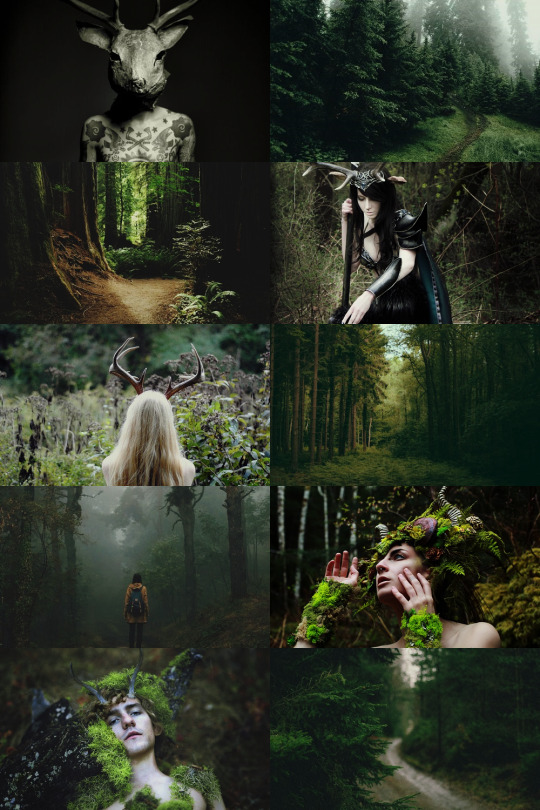
Faun Aesthetic ; requested by @rusticca
The faun is a mythological half human–half goat manifestation of forest and animal spirits that would help or hinder humans at whim. Romans believed fauns inspired fear in men traveling in lonely, remote or wild places. They were also capable of guiding humans in need.
3K notes
·
View notes
